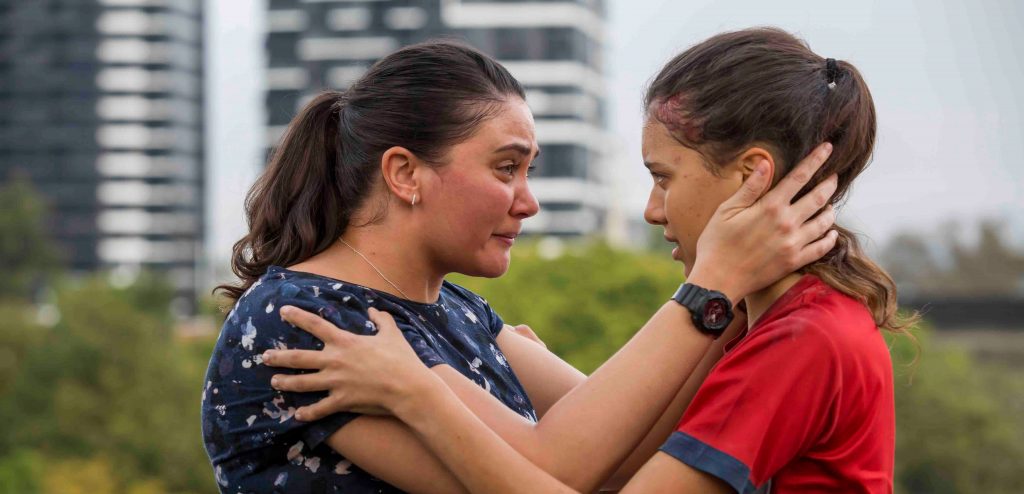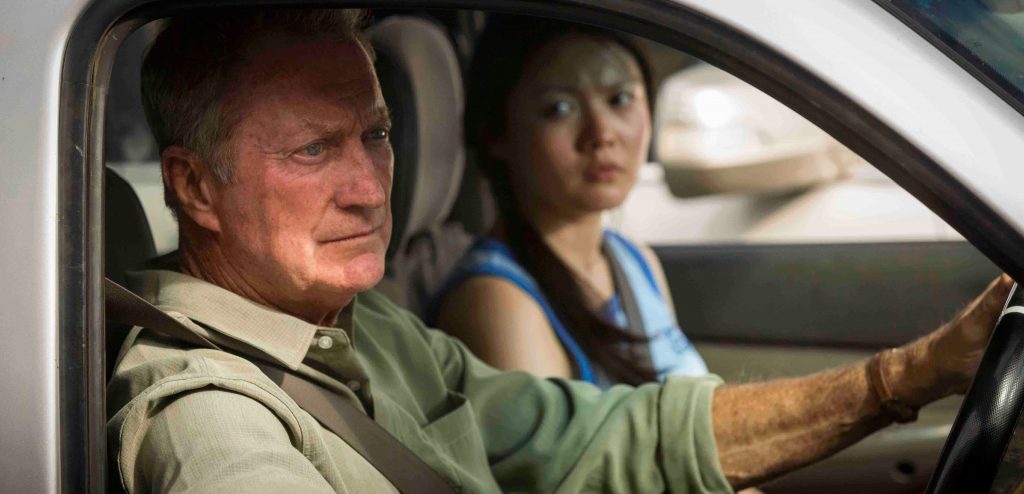Oh boy.
Workaholic director Kriv Stenders and first time feature film writer Stephen M. Irwin have teamed up to whitesplain to Australia how racist it is. Thanks. If you don’t live under a rock, you’ll no doubt be well aware that the issue of racism refuses to remove its ugly head from modern societies around the world. The caustic issue has snowballed to include other forms of discrimination, such as islamophobia, fear of refugees, and xenophobia. In Australia, the Black Lives Matter movement has found footing with Aboriginal deaths in custody. ‘Reclaim Australia’ rallies have become a regular event, with some police officers showing solidarity with racists. All round terrible politician, Pauline Hanson, has returned to Canberra with her equally xenophobic cronies to spout tax payer funded abuse at minorities.
So, naturally, Stenders and Irwin have decided to set this tale of Australian racism on one of the more controversial days on the Australian calendar – Australia Day. For those who need a rapid history lesson, January 26th was the date that Australia (a country already inhabited by many first nations) was invaded by the First Fleet from England. In 1994, the states and territories in Australia united to enshrine the date of January 26th as a public holiday – for many, it’s celebration about what Australia is and stands for, but for the indigenous Australians, it’s a reminder of the tragedy and deaths that fell upon their ancestors. In recent times, councils around Australia have made efforts to recognise this tragedy and have noted that they will not be celebrating Australia Day on January 26. This has caused a growing anger between state and federal governments, as well as white Australia and indigenous Australia. To say it’s a sensitive topic is putting it kindly.
Set in Queensland, the birthplace of Pauline Hanson’s One Nation party, Australia Day opens with everybody in Brisbane going for a run. Well, not everyone, but there is certainly a lot of running that goes on in the film. A terrified Chinese girl (Jenny Wu’s Lan) runs bloody footed through the back streets of Brisbane til she bumps into Bryan Brown’s white saviour senior citizen, Terry. A terrified Aboriginal girl (Miah Madden’s April) flees a car crash that’s attracted more than the fair share of police attention. And finally, a terrified Middle Eastern teenage boy (Elias Anton’s Sami) runs scared from a group of white Aussie thugs. The one thing that unites all of these people is the colour of their skin, and the mere fact that they’re terrified of something that’s chasing them. Immediately, we’re given the understanding that Australia is not a safe place.
Each has their own story to tell, and for some reason, this is all going to go down on Australia Day. Not that you’d know it though, as outside of a brief encounter with a few flag wearing, board short draped group of white guys, and a smattering of radio and TV footage, this could take place on any other day. But, because the hot button date that’s in the Australian social consciousness right now is January 26th, this story is set on that day. Why? Other than to monopolise on the anger associated with the date, there is no reason for it to be set then. It’s opportunistic and shows a level of ignorance that the film excels in. If the day of Australia Day is intended to be a day to celebrate Australia as a whole, then logically a film that is about Australia Day would take a magnifying glass to the date itself and assess the country that is Australia and what it is we are actually celebrating. Stenders and Irwin go to some lengths to do just that, but by pooling together every issue under the sun, they neglect to have a focused agenda on discussing the day itself.
Stenders and Irwin have misconstrued the notion that by presenting acts of racism, violence against minorities, islamophobia, and xenophobia, you are in turn running a commentary on, and a damnation of those acts. Just because you show these things occurring does not mean that the film is condemning them – there needs to be narrative context for the actions of the characters. Yet, in this 100 minute film, there are simply too many characters to fully understand who they are, and too many narrative threads to give each one ample breathing space. Characters feel like they were written with a social issue in mind, rather than being a fully formed character who happens to have those social issues happen to them.
Australia Day wants to be a mea culpa for white Australians, an easy out to say ‘we’re sorry’ and hit the reset button on race relations. But it fails dismally. After all, this is a film where every white person is racist (those flag wearing folks spout out at Miah Madden’s April, ‘invasion day, it’s ours now!’). Every aboriginal knows every other aboriginal. Everybody is either racist or islamophobic. Everybody has an issue that is just destroying their lives – whether it be problems with the banks, drugs, cattle exports, illegal sex rings, and more – and every issue is just making their day the worst. To call this Australia’s version of Crash is too high praise – even though Paul Haggis’ film is muddled and too eager to ‘solve racism’, it is at least a focused film that contains some worthwhile performances.
All of the Asian characters simply exist to reinforce negative Asian stereotypes – all are ignorant, opportunistic, uncaring individuals. Of course the Asian characters run an illegal brothel. Every white person is nefarious and cruel. They’re reactionary and thuggish. If a character is from the Middle East, then they have rules that they must stick to (a mother’s suggestion that a son must do what his father would want him to do – ie. kill someone – is particularly problematic). Again, these are caricatures rather than actual characters. In the end, it all boils down to presenting Facebook-esque depictions of racism.

Shari Sebbens police officer Sonya Mackenzie is the sole aboriginal officer in her unit, and as such is treated with disregard and outward racism. In Stenders Brisbane, every police officer (besides, y’know, the officers of colour) is racist and will only listen to other white folks. This feels like a commentary on the black lives matter movement, yet fails to understand what that movement is even about. And if it isn’t a commentary on that movement, it equally fails as an exploration on the treacherous relationship between Australian police officers and Aboriginal deaths in custody. Every other Aboriginal character comes from a broken home or is addicted to drugs. Again, these aren’t characters – they’re constructions of ideas that speak and move.
Bryan Brown’s reluctant white saviour swoops in to ‘do the right thing’ when his ute is flagged down by Lan. The set dressing within his ute is supremely on the nose with a newspaper sitting in clear eyesight with a headline stating ‘No Fracking’ – where one would usually praise the use of set design to explain who a character is, here it comes through as lazy, and button pushing. It adds another rotten layer to the core of a rotten onion. He sees Lan as a nuisance and just wants the problem to be dealt with so he can move on with his day. If there’s an element of truth within Australia Day, it’s here. The average Australian doesn’t want to address the issues that surround them, they’d rather get on with their own problems and ignore the greater issues at large. But, the film is presented as one that aims to solve all of Australia’s problems in a neat bow.
Australia Day is so convoluted, so over the top and eager to get a reaction, that by the time an assassination plot is revealed, one can’t help but roll their eyes and sigh. Forget the fact that no agriculture minister would ever announce a new trade agreement on Australia Day, the mere notion that this character would want to kill somebody – or themselves – just because of the action of a government, is never earned within this exaggerated version of Australia. We’re well aware of real world issues with rapid globalisation and bank financing and how difficult it is to be a farmer, but these are issues that carry too much weight to be used as short hand for one man’s issues. Thrown on top of this is the notion that he was once a soldier from some nameless war – an attempt to possibly throw another stick another stick into the fire, this time mental health issues.
In one scene, we see Peter Drew’s great ‘Real Aussies Say Welcome’ street art on a wall, and it’s almost enough to anticipate a scene of asylum seekers coming ashore on the Brisbane River. And that’s the main problem with Australia Day. By trying to say everything, it ends up saying nothing. This is not to say that these topics cannot or should not be explored – quite the contrary. In a world where high budget Netflix series that explore deep themes exist, one could imagine an extended, considered expose of all of these issues in one measured, ten hour long run. Even then, you don’t need to go far to see content that has discussed these issues in greater detail – the brilliant Redfern Now, the darkly comedic Down Under, the caustic The Combination, or going back much further, The Chant of Jimmie Blacksmith, and looking into the future, Warwick Thornton’s Sweet Country appears to cover the history of Australia and its relationship with racism superbly.
One could easily drag in the Australian film industry into this debate as well. Australian’s regularly decry the ‘dark and serious’ Australian cinema, and have routinely rejected this kind of fare at the box office. Yet, Australia Day is nothing but dark and serious. This is not to say that that kind of film shouldn’t exist – it definitely should. It’s just that the way this film has been promoted is as ignorant as the film itself. For some reason, Australia Day was used as the film to launch a premium film service run by Foxtel and Dendy. For $20~ you can rent this film for your whole family to watch. But, good intentions can only go so far, and while Stenders and Irwin may like to think Australia is ready to confront racism in via its entertainment, it’s simply not. When One Nation is polling at almost 10% of votes, and Reclaim Australia rallies exist, it’s a reminder that Australia is disinterested in engaging with these subjects. We’re not a self-reflective nation.
We are also certainly not a nation that is going to drop $20~ on a premium on demand film. If this were another entry in the ever popular Red Dog series, then maybe it would garner a home audience, but as it is, nobody is rushing to see what Stenders, Foxtel, Dendy and co. are pushing. The cost of premium content is one of great contention around the world today, and this review isn’t the place to go into the intricacies of it. However, it is worthwhile asking the question of exactly how successful did Foxtel and Dendy think this film would be?
On top of that, when a film that tries to bundle every issue under the sun arrives, it feels disingenuous and false to have such a story written and directed by two white guys. Kriv Stenders has shown to be a competent director who has managed more than one genre of filmmaking, but his earnest talent can only go so far. This is not to say that Stenders is not the man to tell this story, but one can’t help get the feeling that Australia Day is just a cursory glance of a film that exists to tick off a box. In the space of almost twelve months, Stenders has released (deep breath) Red Dog: True Blue, episodes of Hunters, Doctor Doctor and A Place to Call Home, The Go-Betweens: Right Here, the Wake in Fright miniseries, and finally Australia Day. He’s also got two more films on the horizon. I can’t comment on the TV work, but if there’s one comment that can be made about the film work is that they feel rushed and empty. Red Dog: True Blue is solid, and The Go-Betweens documentary is well intentioned but forgetful, and finally Australia Day is a mess. All of these works feel like they could have done with six months more in the oven. Just because Stenders can direct with all the quickness in the world doesn’t mean he should. When Australia is struggling to give new voices a large platform to tell their stories, one has to wonder why Stenders didn’t take the producing seat and give a person of colour the captain’s seat? It’s not as if Australian audiences are genuinely aware of who is directing the films they go and see, so the name Kriv Stenders is not going to be a marquee draw card.
If we break the social issues down a fraction, then we’re reminded that there is a genuine need to explore what Australia Day means to both the first nations of this land, and to modern Australia. Yet, as earnest as it may be, Australia Day fails at every turn in doing that. One of the ways conversations about racism and xenophobia can be explored is through film, and this is a squandered opportunity. The presentation of minority groups in Australia is a brutal one, with the worst aspect of their portrayal being the unshakeable feeling that they simply exist to teach others a lesson in how to be civil. There’s a real sense that the film suggests that the only way to grow as a person, and in turn, as a society, is to enact violence on each other. If this is the case, then this is as bad as the characters actions are.
To be clear – there is a conversation going on in Australia at the moment regarding race relations and where modern Australia stands in regards to its white history. But those conversations are happening from the indigenous community. We live in a society where an indigenous man can walk all the way from Perth to Canberra, talking to his community, listening and understanding the issues that face indigenous Australians in today’s society, with the view of raising these issues in the presence of the Australian government. Only to reach Canberra and be shunned by the Prime Minister. When we have a government who is locking legitimate refugees up in detention on a remote island in the middle of almost nowhere, and a society that appears to support this action, we have to be more controlled and patient when delivering a piece of literature (whether it be film, television or a book) that appears to question the modern society that we live in. I want to be clear – the conversation that Australia Day thinks it’s starting, is one that we desperately need to have on a national level. There are films that do exist within the Australian lexicon that explore the very many issues that Australia Day presents, and all with a greater level of decency than what is presented here.
As it is, Australia Day doesn’t feel like it’s a film that’s actually got anything constructive to say. It wants to present a broken society by holding a mirror up to what’s going on, and demanding us to look at ourselves and shape up. But the mirror is shattered, and the only way the film appears to reflect our world is to pour the broken mirror into a heap and say ‘see, that’s us’. I’d be genuinely surprised if any people of colour or of faith were consulted on this film, and if they were, I wouldn’t be surprised if their voices were ignored. Australia Day may not be the worst Australian film ever made, but it certainly sits up there. Kriv Stenders is a solid director, but one that needs to ease up and allow his projects to simmer and percolate more, otherwise he’s in jeopardy of tarnishing his career.
Director: Kriv Stenders
Cast: Bryan Brown, Shari Sebbens, Sean Keenan
Writer: Stephen M. Irwin



